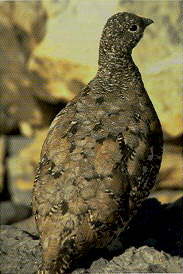
Bats are not the only animals that have a warmth problem during cool
nights and during the winter (previous "Dandy Designs"). Birds also face
problems when the air temperature drops below freezing. Birds solve their
problems by one or a combination of two methods--either increasing their
calorie intake and/or reducing their heat losses. Birds that winter over
in the northern areas in which we live increase their plumage during the
autumn by as much as 30%. Some birds like grouse and ptarmigans grow "after
feathers." These are small feathers that grow from the shafts of their
regular feathers to increase their insulating ability. By fluffing their
feathers during cold periods these birds can boost insulation to 150% of
summer values. A few species do what the bats do and congregate together.
Some nuthatches (a small bird) will cram 20 birds into a hole so they are
packed tightly conserving heat for the night's rest.

Grouse and ptarmigans have another trick that serves them well in snow-covered areas of the north. At dusk you will see them packing their crops with seeds, needles, and twigs. These birds roost in trees during the warm months, but in the winter they will tunnel into the snow and then "swim" several inches so they are completely covered by snow. The temperature of the air may be below zero, but under the snow the temperature is 32 degrees F. The snow around the bird melts and re-freezes forming a cavity with warm air around the bird. All of this can produce a 45% savings in the energy the bird needs to generate.
The food processing of the grouse and ptarmigan is beautifully designed for all of this. The food is ground up in the bird's gizzard and then passed on to the cecum, a fermentation chamber containing microorganisms that can break down cellulose. In the fall, both the crop and the cecum enlarge. In the willow ptarmigan, a fifteen inch bird, the cecum may grow to 45 inches. This huge temporary increase in size allows the birds to store and process food for a long time when winter storms hit.
Allowing life to be able to exist in extreme environments requires some pretty incredible engineering, and the wintering bird speaks eloquently of the design that is built into them to make that possible. Like us, our bird friends can say "We are fearfully and wonderfully made..." (Psalm 139:14).
Back to Contents Does God Exist?, NovDec00.